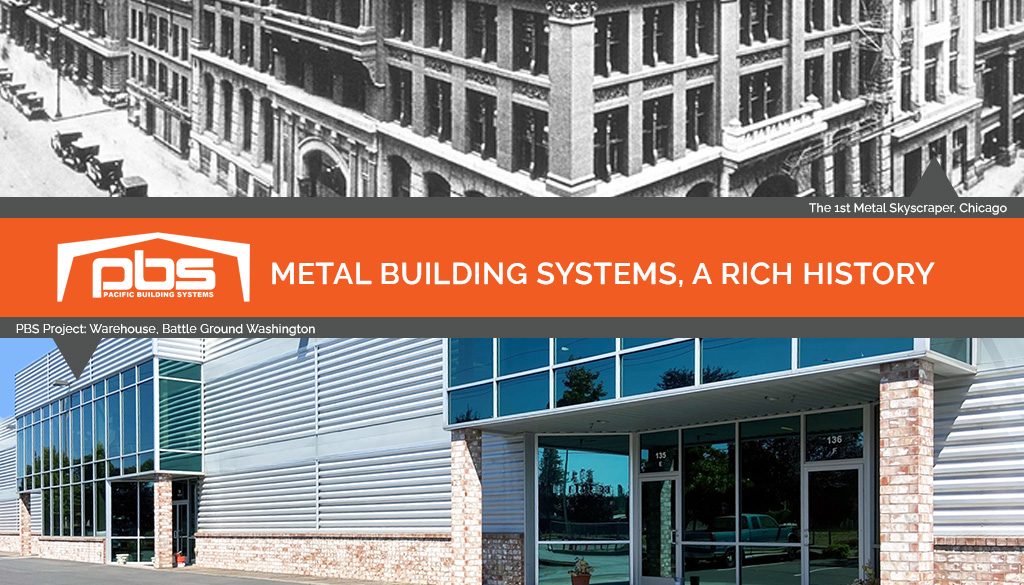Metal Building Systems, A Historical Look
Pacific Building Systems (PBS) has a long history in the Prefabricated Metal Building Industry, but Metal Building Systems have been around for centuries.
According to the Metal Building Manufacturers Association, steel building systems account for nearly 50% of the one- and two-story non-residential building market in the United States? With all the practical benefits offered by prefabricated metal buildings, it’s easy to understand why. Compared to traditional construction methods, pre-engineered metal building systems (PEMBs) are more durable, lower maintenance, more energy-efficient, and meet a wide-range of applications from industrial and commercial, to agricultural, government buildings and more.
Metal building systems date back to the 1700s, but they have advanced through the decades and are now the most popular low-rise commercial building solutions in the United States. In this post, we’ll discuss how prefab metal buildings have changed over time to become the commercial standard.
The History of Metal Building Systems
To understand the present, we have to take a look at the past. The first known metal structures were constructed in the late 1700s in England for cotton mills and agriculture buildings. These innovative new building systems proved to be a more economical choice than brick factories built with brick and timber. It did not take long for factory and mill owners to recognize the benefits of building with less flammable materials.
Like most innovations, pre-engineered metal building systems (PEMBs) began cropping up in New York City and throughout the United States by the early nineteenth century. Steel was still a relatively rare commodity for most civilians in those days, but World War II changed everything. An urgent need for fast construction of housing and shelters resulted in a boom in the metal building systems industry. Prefabricated steel building systems could quickly be constructed, disassembled and transported by an unskilled labor force using basic tools, making them an ideal solution for airplane hangars and Quonset hut housings. Though this new way of building was intended to be a temporary solution, builders, and architects quickly took note of the benefits of metal building systems and utilized them more widely for industrial and agricultural purposes.
By the late 1960s, steel buildings were widely recognized by architects, engineers, and building owners for their durability and speed of construction. These attributes made pre-engineered metal building systems (PEMBs) popular choices for applications like warehouses, storage facilities and public buildings. Despite the advances in the metal building systems industry during the mid-twentieth century, they still lacked design flexibility. Fortunately, the rise of technology and CAD in the mid-1970s enabled steel building manufacturers like Pacific Building Systems to begin custom engineering buildings and offering more design options for specific applications.
Today, steel buildings are one of the most common low-rise commercial buildings and are typically custom designed and manufactured by companies like Pacific Building Systems to fulfill the specific requirements of each customer. Designers can select straight or tapered columns, variable or odd-sized bays or modules, single-slope or double-slope buildings, and more. Pre-engineered metal building systems (PEMBs) systems can be integrated with a variety of accessories and wall materials, such as concrete masonry block, brick, tilt-up concrete, curtain. Modern steel buildings can also be complemented with a range of color choices and different structural additions like mezzanine floors, fascias, canopies, and crane systems.
Benefits of Metal Building Systems by PBS
Unlike other forms of construction, metal buildings designed and engineered by experienced steel building manufacturers like Pacific Building Systems (PBS), offer a more complete solution with practical benefits such as:
- Fast & Effective Construction. PEMBs manufactured by PBS are completed on average between 3 × 5 faster than conventional construction.
- Ready to Assemble Steel Building Components. All elements are factory fabricated, pre-cut and pre-punched under precise factory conditions.
- Reduced Design Time. PBS’s optimized process reduces the time to design, produce, and fabricate- eliminating unexpected costs.
- Cost Effectiveness. PEMB’s reduce up-front costs on nearly every phase of construction without losing quality. On average, our custom- building systems cost less than conventional construction — often up to 30% less.
- Less Expensive to Insure. Because of its superior strength and durability, as well as its resistance to fire and other natural disasters, insurance costs may be lower if you choose a steel building over other materials.
- Inexpensive Repairs. If the building needs repair for one reason or another, you can simply attach another piece of metal over the damaged area. If the damage is larger, it is inexpensive and simple to replace the entire section.
- Highly Customizable, Flexible and Versatile Design & More Open Space. Traditional buildings have supporting columns and don’t provide the whole open space, whereas pre-engineered steel buildings give clear span structure, allowing space to use.
- Fewer Foundation Problems Over Time. Because a steel building requires far fewer pieces of framing than wood, there is less weight on the foundation. Less weight means less settling and therefore less chance of costly foundation problems down the road
Are you thinking about buying a prefabricated steel building kit? PBS has been a leader in manufacturing standard and custom steel buildings throughout the Pacific Northwest and Alaska for over fifty years. Our buildings are computer-designed, which saves you time and money and ensures you get the most up-to-date engineering technology available. PBS offers clear span buildings without interior columns. Single span or multi-span systems can also be erected in a wide range of dimensions and roof slopes. We deliver direct to your site using our own fleet of trucks. Give us a call at 503-981-9581, and we’ll be happy to discuss your next project.
Ready to get started?
We have what it takes to make your next project a reality.
Contact a project consultant today.

